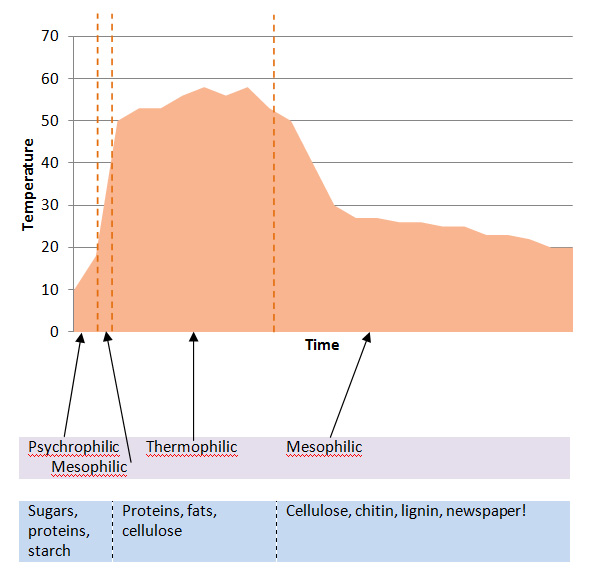In the last post micro organisms took centre stage. These are the single-celled little guys who are going to eat up all those banana skins and pizza boxes to make nutritious humus for my roses. What heroes. But how are they going to do that and how long will it take, and who are they?
The vast majority are bacteria. Most are the kind you wouldn’t want to meet on a dark night, but some are responsible for the antibiotics we use to fight illnesses like TB. Bacteria will eat anything, living or dead. The general idea is that they will break down matter to use the carbon and nitrogen and in doing so release gases like CO2, generate heat, and finally leave organic matter that can be used by plants.
There are three types of bacteria that get to work at different times in a compost bin:
- Psychrophilic – appear when the compost is new and cold. They prefer temperatures between 10 and 21C.
- Mesophilic – are dominant when the internal temperature rises to 21 - 38C. If there is not enough nitrogen or oxygen the compost will stay at this phase and will not develop further, so the pile needs to be turned to give these bacteria plenty of food.
- Thermophilic – appear when the compost gets hot. It’s only after the temperature reaches about 70C or they run out of carbon that the population declines.
It is surprising how quickly the temperature inside the bin rises. The earlier cooler phases last only a few days. By breaking down the sugars and starches that are easy to get to the early bacteria populations raise the temperature enough for the thermophilic bacteria to grow. It is during this hot phase when dangerous pathogens get killed off and more difficult cellulose rich material is broken down. After this intense phase, which could last days or months, a longer more sedate period starts where the work really begins. I imagine this is when they creepy crawlies and worms do their stuff.
I’ve just stuck a cooking thermometer (normally used by my son to temper his chocolate – that’s another story) into my compost bin. It’s 26C, which means it’s still in the mesophilic stage. Super. The little guys are starting to do their thing, but the big boys haven’t arrived yet. (And yes, mum, I did clean the thermometer after)
I hope this little exposition hasn’t been too boring. Bear with me, it’s just that I’m a little in love with my compost bin at the moment and I want to know ALL about him.
